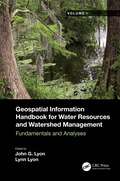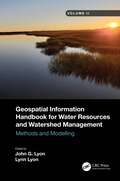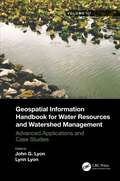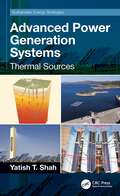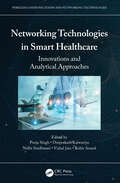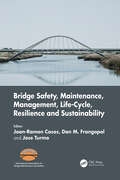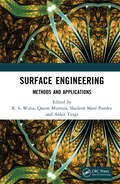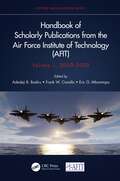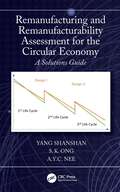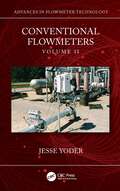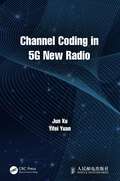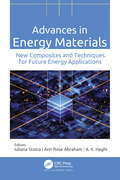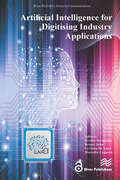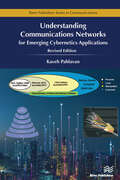- Table View
- List View
Geospatial Information Handbook for Water Resources and Watershed Management, Volume I: Fundamentals and Analyses
by Lyon John G.Volume I of Geospatial Information Handbook for Water Resources and Watershed Management discusses fundamental characteristics, measurements, and analyses of water features and watersheds including lakes and reservoirs, rivers and streams, and coasts and estuaries. It presents contemporary knowledge on Geospatial Technology (GT)–supported functional analyses of water runoff, storage and balance, flooding and floodplains, water quality, soils and moisture, climate vulnerabilities, and ecosystem services. Captures advanced Geospatial Technologies (GTs) addressing a wide range of water issues Provides real-world applications and case studies using advanced spectral and spatial sensors combined with geospatially facilitated water process models Details applications of ArcInfo/ArcGIS, Google Earth Engine, and other systems using advanced remote sensors, including hyperspectral ER2 AVIRIS, Sentinel-1 and -2, MODIS, Landsat 7 ETM+, Landsat 8 OLI and TIPS, SAR radar, and thermal imaging Global in coverage with applications contributed by more than 170 authors with lifelong expertise in water sciences and engineering This handbook is a wide-ranging and contemporary reference of advanced geospatial techniques used in numerous practical applications at the local and regional scales and is an in-depth resource for professionals and the water research community worldwide.
Geospatial Information Handbook for Water Resources and Watershed Management, Volume II: Methods and Modelling
by G. Lyon JohnVolume II of Geospatial Information Handbook for Water Resources and Watershed Management discusses Geospatial Technology (GT) approaches using integrated modeling as applied to advanced water resource assessments. Features include multiple date land cover analyses as change in land cover influences water quality, model sensitivity analyses of DEM resolution and influences on modeling water characteristics like Manning’s n, development of seabed cover classification and sensitivity, and forecasting urban growth over time with climate vulnerability impacts on water. A detailed case study presents a range of water quality issues, all effectively demonstrating GT inputs to water quality studies from headwaters to receiving estuarine waters. Also analyzed are the comparison of evapotranspiration simulation performance by APEX model in dryland and irrigated cropping systems and perspectives on the future of transient storage modeling. Captures advanced technologies and applications for implementation with models to address a broad spectrum of water issues Provides real-world applications and case studies using advanced spectral and spatial sensors combined with geospatially facilitated water process models Features a Neuse River Basin case study integrating hydrologic methods and modeling along with remote sensing and GIS technologies for nonpoint source water quality evaluations Global coverage with applications demonstrated by more than 170 experts from around the world This handbook is a wide-ranging and contemporary reference of advanced geospatial techniques used in numerous practical applications at the local and regional scale and is an in-depth resource for professionals and the water research community worldwide.
Geospatial Information Handbook for Water Resources and Watershed Management, Volume III: Advanced Applications and Case Studies
by John G. Lyon Lynn LyonVolume III of Geospatial Information Handbook for Water Resources and Watershed Management discusses water and watershed issues such as water quality, evapotranspiration, water resource management, and ecological services. Featured is a two-stage ditch and river geomorphology case study section with related water geospatial applications, including historical image analyses of floodplains and channels and resulting change in river geomorphology through erosion and transport and influence on dependent vegetation communities. Captures advanced Geospatial Technologies (GT) and their applications to address a wide spectrum of water issues Provides real-world two-stage ditch and river geomorphology case studies using river, stream and channel measures and change models, and bankfull discharge modeling Global in coverage with applications demonstrated by more than 170 experts in water sciences and two-stage ditch and river geomorphology This handbook is a wide-ranging and contemporary reference of advanced geospatial techniques used in numerous practical applications at the local and regional scale and is an in-depth resource for professionals and the water research community worldwide.
Geospatial Information Handbook for Water Resources and Watershed Management, Volume I: Fundamentals and Analyses
by John G. Lyon Lynn LyonVolume I of Geospatial Information Handbook for Water Resources and Watershed Management discusses fundamental characteristics, measurements, and analyses of water features and watersheds including lakes and reservoirs, rivers and streams, and coasts and estuaries. It presents contemporary knowledge on Geospatial Technology (GT)–supported functional analyses of water runoff, storage and balance, flooding and floodplains, water quality, soils and moisture, climate vulnerabilities, and ecosystem services. Captures advanced Geospatial Technologies (GTs) addressing a wide range of water issues Provides real-world applications and case studies using advanced spectral and spatial sensors combined with geospatially facilitated water process models Details applications of ArcInfo/ArcGIS, Google Earth Engine, and other systems using advanced remote sensors, including hyperspectral ER2 AVIRIS, Sentinel-1 and -2, MODIS, Landsat 7 ETM+, Landsat 8 OLI and TIPS, SAR radar, and thermal imaging Global in coverage with applications contributed by more than 170 authors with lifelong expertise in water sciences and engineering This handbook is a wide-ranging and contemporary reference of advanced geospatial techniques used in numerous practical applications at the local and regional scales and is an in-depth resource for professionals and the water research community worldwide.
Geospatial Information Handbook for Water Resources and Watershed Management, Volume II: Methods and Modelling
by John G. Lyon Lynn LyonVolume II of Geospatial Information Handbook for Water Resources and Watershed Management discusses Geospatial Technology (GT) approaches using integrated modeling as applied to advanced water resource assessments. Features include multiple date land cover analyses as change in land cover influences water quality, model sensitivity analyses of DEM resolution and influences on modeling water characteristics like Manning’s n, development of seabed cover classification and sensitivity, and forecasting urban growth over time with climate vulnerability impacts on water. A detailed case study presents a range of water quality issues, all effectively demonstrating GT inputs to water quality studies from headwaters to receiving estuarine waters. Also analyzed are the comparison of evapotranspiration simulation performance by APEX model in dryland and irrigated cropping systems and perspectives on the future of transient storage modeling. Captures advanced technologies and applications for implementation with models to address a broad spectrum of water issues Provides real-world applications and case studies using advanced spectral and spatial sensors combined with geospatially facilitated water process models Features a Neuse River Basin case study integrating hydrologic methods and modeling along with remote sensing and GIS technologies for nonpoint source water quality evaluations Global coverage with applications demonstrated by more than 170 experts from around the world This handbook is a wide-ranging and contemporary reference of advanced geospatial techniques used in numerous practical applications at the local and regional scale and is an in-depth resource for professionals and the water research community worldwide.
Advanced Power Generation Systems: Thermal Sources (Sustainable Energy Strategies)
by Yatish T. ShahAdvanced Power Generation Systems: Thermal Sources evaluates advances made in heat-to-power technologies for conventional combustion heat and nuclear heat, along with natural sources of geothermal, solar, and waste heat generated from the use of different sources. These advances will render the landscape of power generation significantly different in just a few decades. This book covers the commercial viability of advanced technologies and identifies where more work needs to be done. Since power is the future of energy, these technologies will remain sustainable over a long period of time. Key Features Covers power generation and heat engines Details photovoltaics, thermo-photovoltaics, and thermoelectricity Includes discussion of nuclear and renewable energy as well as waste heat This book will be useful for advanced students, researchers, and professionals interested in power generation and energy industries.
Advanced Power Generation Systems: Thermal Sources (Sustainable Energy Strategies)
by Yatish T. ShahAdvanced Power Generation Systems: Thermal Sources evaluates advances made in heat-to-power technologies for conventional combustion heat and nuclear heat, along with natural sources of geothermal, solar, and waste heat generated from the use of different sources. These advances will render the landscape of power generation significantly different in just a few decades. This book covers the commercial viability of advanced technologies and identifies where more work needs to be done. Since power is the future of energy, these technologies will remain sustainable over a long period of time. Key Features Covers power generation and heat engines Details photovoltaics, thermo-photovoltaics, and thermoelectricity Includes discussion of nuclear and renewable energy as well as waste heat This book will be useful for advanced students, researchers, and professionals interested in power generation and energy industries.
Networking Technologies in Smart Healthcare: Innovations and Analytical Approaches (Wireless Communications and Networking Technologies)
by Pooja Singh Omprakash Kaiwartya Nidhi Sindhwani Vishal Jain Rohit AnandThis text provides novel smart network systems, wireless telecommunications infrastructures, and computing capabilities to help healthcare systems using computing techniques like IoT, cloud computing, machine and deep learning Big Data along with smart wireless networks. It discusses important topics, including robotics manipulation and analysis in smart healthcare industries, smart telemedicine framework using machine learning and deep learning, role of UAV and drones in smart hospitals, virtual reality based on 5G/6G and augmented reality in healthcare systems, data privacy and security, nanomedicine, and cloud-based artificial intelligence in healthcare systems. The book: • Discusses intelligent computing through IoT and Big Data in secure and smart healthcare systems. • Covers algorithms, including deterministic algorithms, randomized algorithms, iterative algorithms, and recursive algorithms. • Discusses remote sensing devices in hospitals and local health facilities for patient evaluation and care. • Covers wearable technology applications such as weight control and physical activity tracking for disease prevention and smart healthcare. This book will be useful for senior undergraduate, graduate students, and academic researchers in areas such as electrical engineering, electronics and communication engineering, computer science, and information technology. Discussing concepts of smart networks, advanced wireless communication, and technologies in setting up smart healthcare services, this text will be useful for senior undergraduate, graduate students, and academic researchers in areas such as electrical engineering, electronics and communication engineering, computer science, and information technology. It covers internet of things (IoT) implementation and challenges in healthcare industries, wireless network, and communication-based optimization algorithms for smart healthcare devices.
Networking Technologies in Smart Healthcare: Innovations and Analytical Approaches (Wireless Communications and Networking Technologies)
by Pooja Singh Omprakash Kaiwartya Nidhi Sindhwani Vishal Jain Rohit AnandThis text provides novel smart network systems, wireless telecommunications infrastructures, and computing capabilities to help healthcare systems using computing techniques like IoT, cloud computing, machine and deep learning Big Data along with smart wireless networks. It discusses important topics, including robotics manipulation and analysis in smart healthcare industries, smart telemedicine framework using machine learning and deep learning, role of UAV and drones in smart hospitals, virtual reality based on 5G/6G and augmented reality in healthcare systems, data privacy and security, nanomedicine, and cloud-based artificial intelligence in healthcare systems. The book: • Discusses intelligent computing through IoT and Big Data in secure and smart healthcare systems. • Covers algorithms, including deterministic algorithms, randomized algorithms, iterative algorithms, and recursive algorithms. • Discusses remote sensing devices in hospitals and local health facilities for patient evaluation and care. • Covers wearable technology applications such as weight control and physical activity tracking for disease prevention and smart healthcare. This book will be useful for senior undergraduate, graduate students, and academic researchers in areas such as electrical engineering, electronics and communication engineering, computer science, and information technology. Discussing concepts of smart networks, advanced wireless communication, and technologies in setting up smart healthcare services, this text will be useful for senior undergraduate, graduate students, and academic researchers in areas such as electrical engineering, electronics and communication engineering, computer science, and information technology. It covers internet of things (IoT) implementation and challenges in healthcare industries, wireless network, and communication-based optimization algorithms for smart healthcare devices.
Bridge Safety, Maintenance, Management, Life-Cycle, Resilience and Sustainability: Proceedings of the Eleventh International Conference on Bridge Maintenance, Safety and Management (IABMAS 2022), Barcelona, Spain, July 11-15, 2022
by Joan-Ramon CasasBridge Safety, Maintenance, Management, Life-Cycle, Resilience and Sustainability contains lectures and papers presented at the Eleventh International Conference on Bridge Maintenance, Safety and Management (IABMAS 2022, Barcelona, Spain, 11–15 July, 2022). This e-book contains the full papers of 322 contributions presented at IABMAS 2022, including the T.Y. Lin Lecture, 4 Keynote Lectures, and 317 technical papers from 36 countries all around the world. The contributions deal with the state-of-the-art as well as emerging concepts and innovative applications related to the main aspects of safety, maintenance, management, life-cycle, resilience, sustainability and technological innovations of bridges. Major topics include: advanced bridge design, construction and maintenance approaches, safety, reliability and risk evaluation, life-cycle management, life-cycle, resilience, sustainability, standardization, analytical models, bridge management systems, service life prediction, structural health monitoring, non-destructive testing and field testing, robustness and redundancy, durability enhancement, repair and rehabilitation, fatigue and corrosion, extreme loads, needs of bridge owners, whole life costing and investment for the future, financial planning and application of information and computer technology, big data analysis and artificial intelligence for bridges, among others. This volume provides both an up-to-date overview of the field of bridge engineering and significant contributions to the process of making more rational decisions on bridge safety, maintenance, management, life-cycle, resilience and sustainability of bridges for the purpose of enhancing the welfare of society. The volume serves as a valuable reference to all concerned with and/or involved in bridge structure and infrastructure systems, including students, researchers and practitioners from all areas of bridge engineering.
Bridge Safety, Maintenance, Management, Life-Cycle, Resilience and Sustainability: Proceedings of the Eleventh International Conference on Bridge Maintenance, Safety and Management (IABMAS 2022), Barcelona, Spain, July 11-15, 2022
by Joan Ramon Casas Dan M. Frangopol Jose TurmoBridge Safety, Maintenance, Management, Life-Cycle, Resilience and Sustainability contains lectures and papers presented at the Eleventh International Conference on Bridge Maintenance, Safety and Management (IABMAS 2022, Barcelona, Spain, 11–15 July, 2022). This e-book contains the full papers of 322 contributions presented at IABMAS 2022, including the T.Y. Lin Lecture, 4 Keynote Lectures, and 317 technical papers from 36 countries all around the world. The contributions deal with the state-of-the-art as well as emerging concepts and innovative applications related to the main aspects of safety, maintenance, management, life-cycle, resilience, sustainability and technological innovations of bridges. Major topics include: advanced bridge design, construction and maintenance approaches, safety, reliability and risk evaluation, life-cycle management, life-cycle, resilience, sustainability, standardization, analytical models, bridge management systems, service life prediction, structural health monitoring, non-destructive testing and field testing, robustness and redundancy, durability enhancement, repair and rehabilitation, fatigue and corrosion, extreme loads, needs of bridge owners, whole life costing and investment for the future, financial planning and application of information and computer technology, big data analysis and artificial intelligence for bridges, among others. This volume provides both an up-to-date overview of the field of bridge engineering and significant contributions to the process of making more rational decisions on bridge safety, maintenance, management, life-cycle, resilience and sustainability of bridges for the purpose of enhancing the welfare of society. The volume serves as a valuable reference to all concerned with and/or involved in bridge structure and infrastructure systems, including students, researchers and practitioners from all areas of bridge engineering.
Surface Engineering: Methods and Applications
by R. S. Walia Qasim Murtaza Shailesh Mani Pandey Ankit TyagiSurface engineering is considered an important aspect in the reduction of friction and wear. This reference text discusses a wide range of surface engineering technologies along with applications in a comprehensive manner. The book describes various methods in surface engineering technology with a thorough explanation of various aspects of each process that comes under this domain. Apart from an enhanced explanation of the process and its attributes, this book also gives insight into the types of materials, applications, and optimization of surface engineering techniques. It discusses important topics including surface engineering of the functionality of graded materials, materials characterization, processing of biomaterials, design, surface modification technologies and process control, smart manufacturing, artificial intelligence, and machine learning applications. The book • discusses computational and simulation analyses for better selection of process parameters. • covers optimizations of processes with state-of-the-art technologies. • discusses applications of surface engineering in medical, agricultural, architecture engineering, and allied sectors. • covers processing techniques of biomaterials in surface engineering. The text is useful for senior undergraduate, graduate students, and academic researchers working in diverse areas such as industrial and production engineering, mechanical engineering, materials science, and manufacturing science. It covers a hybrid process for surface modification, modeling techniques, and issues in surface engineering.
Surface Engineering: Methods and Applications
by R. S. Walia Qasim Murtaza Shailesh Mani Pandey Ankit TyagiSurface engineering is considered an important aspect in the reduction of friction and wear. This reference text discusses a wide range of surface engineering technologies along with applications in a comprehensive manner. The book describes various methods in surface engineering technology with a thorough explanation of various aspects of each process that comes under this domain. Apart from an enhanced explanation of the process and its attributes, this book also gives insight into the types of materials, applications, and optimization of surface engineering techniques. It discusses important topics including surface engineering of the functionality of graded materials, materials characterization, processing of biomaterials, design, surface modification technologies and process control, smart manufacturing, artificial intelligence, and machine learning applications. The book • discusses computational and simulation analyses for better selection of process parameters. • covers optimizations of processes with state-of-the-art technologies. • discusses applications of surface engineering in medical, agricultural, architecture engineering, and allied sectors. • covers processing techniques of biomaterials in surface engineering. The text is useful for senior undergraduate, graduate students, and academic researchers working in diverse areas such as industrial and production engineering, mechanical engineering, materials science, and manufacturing science. It covers a hybrid process for surface modification, modeling techniques, and issues in surface engineering.
Handbook of Scholarly Publications from the Air Force Institute of Technology (Systems Innovation Book Series)
by Adedeji B. BadiruThis handbook represents a collection of previously published technical journal articles of the highest caliber originating from the Air Force Institute of Technology (AFIT). The collection will help promote and affirm the leading-edge technical publications that have emanated from AFIT, for the first time presented as a cohesive collection. In its over 100 years of existence, AFIT has produced the best technical minds for national defense and has contributed to the advancement of science and technology through technology transfer throughout the nation. This handbook fills the need to share the outputs of AFIT that can guide further advancement of technical areas that include cutting-edge technologies such as blockchain, machine learning, additive manufacturing, 5G technology, navigational tools, advanced materials, energy efficiency, predictive maintenance, the internet of things, data analytics, systems of systems, modeling & simulation, aerospace product development, virtual reality, resource optimization, and operations management. There is a limitless vector to how AFIT’s technical contributions can impact the society. Handbook of Scholarly Publications from the Air Force Institute of Technology (AFIT), Volume 1, 2000-2020, is a great reference for students, teachers, researchers, consultants, and practitioners in broad spheres of engineering, business, industry, academia, the military, and government.
Handbook of Scholarly Publications from the Air Force Institute of Technology (Systems Innovation Book Series)
by Adedeji B. Badiru Frank W. Ciarallo Eric G. MbonimpaThis handbook represents a collection of previously published technical journal articles of the highest caliber originating from the Air Force Institute of Technology (AFIT). The collection will help promote and affirm the leading-edge technical publications that have emanated from AFIT, for the first time presented as a cohesive collection. In its over 100 years of existence, AFIT has produced the best technical minds for national defense and has contributed to the advancement of science and technology through technology transfer throughout the nation. This handbook fills the need to share the outputs of AFIT that can guide further advancement of technical areas that include cutting-edge technologies such as blockchain, machine learning, additive manufacturing, 5G technology, navigational tools, advanced materials, energy efficiency, predictive maintenance, the internet of things, data analytics, systems of systems, modeling & simulation, aerospace product development, virtual reality, resource optimization, and operations management. There is a limitless vector to how AFIT’s technical contributions can impact the society. Handbook of Scholarly Publications from the Air Force Institute of Technology (AFIT), Volume 1, 2000-2020, is a great reference for students, teachers, researchers, consultants, and practitioners in broad spheres of engineering, business, industry, academia, the military, and government.
Remanufacturing and Remanufacturability Assessment for the Circular Economy: A Solutions Guide
by Yang Shanshan S. K. Ong A.Y.C. NeeThis book presents decision support tools that can be used in the early design stage to analyze the feasibility of a product and its components for remanufacturing. It also covers how to design a product specifically for remanufacturing and offers supporting case studies. This is a comprehensive solutions guide for remanufacturing decision-making. The book illustrates an approach that can be used at the product End-of-Life (EOL) stage to generate optimized recovery plans for the returned products. Opportunities for Industry 4.0 to support remanufacturing along with case studies are included to showcase the decision-making tools. Remanufacturing and Remanufacturability Assessment for the Circular Economy: A Solutions Guide will be of interest to practitioners, business professionals, and researchers that work in the industrial and manufacturing sectors. Those involved with supply chain management and advanced technologies associated with Industry 4.0, sustainability, and integrated techniques of circular supply chains will also find this book very useful.
Remanufacturing and Remanufacturability Assessment for the Circular Economy: A Solutions Guide
by Yang Shanshan S. K. Ong A.Y.C. NeeThis book presents decision support tools that can be used in the early design stage to analyze the feasibility of a product and its components for remanufacturing. It also covers how to design a product specifically for remanufacturing and offers supporting case studies. This is a comprehensive solutions guide for remanufacturing decision-making. The book illustrates an approach that can be used at the product End-of-Life (EOL) stage to generate optimized recovery plans for the returned products. Opportunities for Industry 4.0 to support remanufacturing along with case studies are included to showcase the decision-making tools. Remanufacturing and Remanufacturability Assessment for the Circular Economy: A Solutions Guide will be of interest to practitioners, business professionals, and researchers that work in the industrial and manufacturing sectors. Those involved with supply chain management and advanced technologies associated with Industry 4.0, sustainability, and integrated techniques of circular supply chains will also find this book very useful.
Conventional Flowmeters: Volume II
by Jesse YoderConventional Flowmeters covers origin, principle of operation, development, advantages and disadvantages, applications, and frontiers of research for conventional technology flowmeters, which include differential pressure and primary elements, positive displacement, turbine, open channel, and variable area. There are more conventional technology meters being used in the field than new-technology meters. New developments, such as more accurate pressure transmitters, new primary elements such as cone elements, reversible flow, and dual rotor turbine meters, and variable area meters with transmitters and a signal output, are discussed. Features: Offers a working knowledge of the origin and development of the more traditional technology flowmeters: differential pressure and primary elements, positive displacement, turbine, open channel, and variable area. Describes how these conventional meters still fit into what is being called Industry 4.0. Discusses the advantages and disadvantages of conventional technology meters and provides a rationale for retaining or replacing these meters. Focuses on the origin, development operating principles, and applications for the meters. Explores the development of each conventional flowmeter type, including the roles of companies such as Siemens, ABB, Emerson, Foxboro, KROHNE, and Endress+Hauser. This book is designed for anyone involved with flowmeters and instrumentation, including product and marketing managers, strategic planners, application engineers, and distributors.
Conventional Flowmeters: Volume II
by Jesse YoderConventional Flowmeters covers origin, principle of operation, development, advantages and disadvantages, applications, and frontiers of research for conventional technology flowmeters, which include differential pressure and primary elements, positive displacement, turbine, open channel, and variable area. There are more conventional technology meters being used in the field than new-technology meters. New developments, such as more accurate pressure transmitters, new primary elements such as cone elements, reversible flow, and dual rotor turbine meters, and variable area meters with transmitters and a signal output, are discussed. Features: Offers a working knowledge of the origin and development of the more traditional technology flowmeters: differential pressure and primary elements, positive displacement, turbine, open channel, and variable area. Describes how these conventional meters still fit into what is being called Industry 4.0. Discusses the advantages and disadvantages of conventional technology meters and provides a rationale for retaining or replacing these meters. Focuses on the origin, development operating principles, and applications for the meters. Explores the development of each conventional flowmeter type, including the roles of companies such as Siemens, ABB, Emerson, Foxboro, KROHNE, and Endress+Hauser. This book is designed for anyone involved with flowmeters and instrumentation, including product and marketing managers, strategic planners, application engineers, and distributors.
Channel Coding in 5G New Radio
by Jun Xu Yifei YuanThis book provides a comprehensive coverage of major channel codes adopted since the 3rd generation of mobile communication. Modulation schemes suitable for 5G mobile communications are also described based on key New Radio application scenarios and performance requirements. It covers low density parity check (LDPC) codes, Polar codes, tail-biting convolutional codes (TBCC) and Turbo codes. Outer codes and a few advanced coding and modulations are also discussed. In addition, it includes detailed illustration of each channel coding scheme such as the basic code structure, decoding algorithms, performance evaluation and complexity analysis. The book offers insights on why and how channel codes are designed and developed in standardization organizations, which significantly facilitates the reading and understanding of the of 5G channel coding technologies. Channel Coding in 5G New Radio will be an essential read for researchers and students of digital communications, wireless communications engineers, and those who are interested in mobile communications in general.
Channel Coding in 5G New Radio
by Jun Xu Yifei YuanThis book provides a comprehensive coverage of major channel codes adopted since the 3rd generation of mobile communication. Modulation schemes suitable for 5G mobile communications are also described based on key New Radio application scenarios and performance requirements. It covers low density parity check (LDPC) codes, Polar codes, tail-biting convolutional codes (TBCC) and Turbo codes. Outer codes and a few advanced coding and modulations are also discussed. In addition, it includes detailed illustration of each channel coding scheme such as the basic code structure, decoding algorithms, performance evaluation and complexity analysis. The book offers insights on why and how channel codes are designed and developed in standardization organizations, which significantly facilitates the reading and understanding of the of 5G channel coding technologies. Channel Coding in 5G New Radio will be an essential read for researchers and students of digital communications, wireless communications engineers, and those who are interested in mobile communications in general.
Advances in Energy Materials: New Composites and Techniques for Future Energy Applications
by Iuliana Stoica Ann Rose Abraham A. K. HaghiThis new volume focuses on materials used for energy generation and includes a wide spectrum of applications to solve alternative energy issues. The book reviews the state-of-the-art issues in global energy problems and reports on advanced methods of preparation of nanoscale energy materials with explanations of the structure and properties. It highlights current developments in the energy sector from the materials angle along with new techniques. Topics include polymer nanocomposites with smart behavior and their applicability of in energy applications; magnetorheological and electrorheological properties of smart polymer systems and their energy-related applications; metal-organic frameworks-emerging porous materials for energy applications; applications of carbon nanotubes in energy harvesting and storage; new developments in piezoelectric materials; and much more.
Advances in Energy Materials: New Composites and Techniques for Future Energy Applications
This new volume focuses on materials used for energy generation and includes a wide spectrum of applications to solve alternative energy issues. The book reviews the state-of-the-art issues in global energy problems and reports on advanced methods of preparation of nanoscale energy materials with explanations of the structure and properties. It highlights current developments in the energy sector from the materials angle along with new techniques. Topics include polymer nanocomposites with smart behavior and their applicability of in energy applications; magnetorheological and electrorheological properties of smart polymer systems and their energy-related applications; metal-organic frameworks-emerging porous materials for energy applications; applications of carbon nanotubes in energy harvesting and storage; new developments in piezoelectric materials; and much more.
Artificial Intelligence for Digitising Industry – Applications
by Ovidiu Vermesan Reiner John Cristina De Luca Marcello CoppolaThis book provides in-depth insights into use cases implementing artificial intelligence (AI) applications at the edge. It covers new ideas, concepts, research, and innovation to enable the development and deployment of AI, the industrial internet of things (IIoT), edge computing, and digital twin technologies in industrial environments. The work is based on the research results and activities of the AI4DI project, including an overview of industrial use cases, research, technological innovation, validation, and deployment. This book’s sections build on the research, development, and innovative ideas elaborated for applications in five industries: automotive, semiconductor, industrial machinery, food and beverage, and transportation. The articles included under each of these five industrial sectors discuss AI-based methods, techniques, models, algorithms, and supporting technologies, such as IIoT, edge computing, digital twins, collaborative robots, silicon-born AI circuit concepts, neuromorphic architectures, and augmented intelligence, that are anticipating the development of Industry 5.0. Automotive applications cover use cases addressing AI-based solutions for inbound logistics and assembly process optimisation, autonomous reconfigurable battery systems, virtual AI training platforms for robot learning, autonomous mobile robotic agents, and predictive maintenance for machines on the level of a digital twin. AI-based technologies and applications in the semiconductor manufacturing industry address use cases related to AI-based failure modes and effects analysis assistants, neural networks for predicting critical 3D dimensions in MEMS inertial sensors, machine vision systems developed in the wafer inspection production line, semiconductor wafer fault classifications, automatic inspection of scanning electron microscope cross-section images for technology verification, anomaly detection on wire bond process trace data, and optical inspection. The use cases presented for machinery and industrial equipment industry applications cover topics related to wood machinery, with the perception of the surrounding environment and intelligent robot applications. AI, IIoT, and robotics solutions are highlighted for the food and beverage industry, presenting use cases addressing novel AI-based environmental monitoring; autonomous environment-aware, quality control systems for Champagne production; and production process optimisation and predictive maintenance for soybeans manufacturing. For the transportation sector, the use cases presented cover the mobility-as-a-service development of AI-based fleet management for supporting multimodal transport. This book highlights the significant technological challenges that AI application developments in industrial sectors are facing, presenting several research challenges and open issues that should guide future development for evolution towards an environment-friendly Industry 5.0. The challenges presented for AI-based applications in industrial environments include issues related to complexity, multidisciplinary and heterogeneity, convergence of AI with other technologies, energy consumption and efficiency, knowledge acquisition, reasoning with limited data, fusion of heterogeneous data, availability of reliable data sets, verification, validation, and testing for decision-making processes.
Understanding Communications Networks – for Emerging Cybernetics Applications
by Kaveh PahlavanInformation networking has emerged as a multidisciplinary diversified area of research over the past few decades. From traditional wired telephony to cellular voice telephony and from wired access to wireless access to the Internet, information networks have profoundly impacted our lifestyles as they have undergone enormous growth. To understand this technology, students need to learn several disciplines and develop an intuitive feeling of how they interact with one another. To achieve this goal, the book describes important networking standards, classifying their underlying technologies in a logical manner and gives detailed examples of successful applications.The emergence of wireless access and dominance of the Ethernet in LAN technologies has shifted the innovations in networking towards the physical layer and characteristics of the medium. This book pays attention to the physical layer while we provide fundamentals of information networking technologies which are used in wired and wireless networks designed for local and wide area operations. The book provides a comprehensive treatment of the wired IEEE802.3 Ethernet, and Internet as well as ITU cellular 2G-6G wireless networks, IEEE 802.11 for Wi-Fi, and IEEE 802.15 for Bluetooth, ZigBee and ultra-wideband (UWB) technologies. The novelty of the book is that it places emphasis on physical communications issues related to formation and transmission of packets and characteristics of the medium for transmission in variety of networks.Material presented in the book will be beneficial for students of Electrical and Computer Engineering, Computer Science, Robotics Engineering, Biomedical Engineering, or other disciplines who are interested in integration of navigation into their multi-disciplinary projects. The book provides examples with supporting MATLAB codes and hands-on projects throughout to improve the ability of the readers to understand and implement variety of algorithms.
